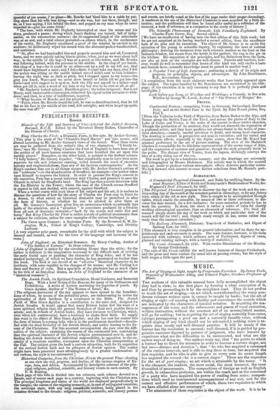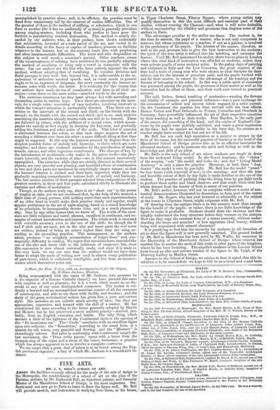MUSIC.
The Art of Singing at Sight, taught by Progressive Exercises. By James Turk, Organist of Westminster Abbey, and Edward Taylor, Gresham Professor of Music.
THE authors of this valuable manual have fully accomplished the object they had in view; in the first place by forming a clear conception of it, and then by proceeding to it by the straightest road. They do not profess to teach the art of singing,—an art which, notwithstanding the many pon- derous volumes written upon it, cannot be taught by books; but the art of singing at sight—of uttering with facility and correctness the sounds which are indicated by the characters of musical notation. In acquiring the ma- nagement of the voice, and the refinements and graces of vocal execution, written instruction, without the constant aid of an accomplished master, will go for nothing; but in acquiring the art of singing correctly from notes, (always presupposing a good ear and a naturally tunable voice, without which singing of any kind should not be attempted,) nothing more is re- quisite than steady and well-directed practice. It will be steady if the learner has the resolution to succeed; well directed, if it is guided by pro- gressive exercises digested by persons of judgment, who have learned by experience what are the difficulties to be surmounted, and what are the easiest ways of doing so. Our authors truly say, that " the points to which a learner has to direct his attention in order to become a correct singer, are but two—distance and duration"; that " he who has acquired a command of the various intervals, and is able to sing them in tune, has acquired the first requisite, and he who is able to give to every note its exact length his acquired the second—he is a correct singer." These are the requisites for the art of part-singing; an art which is attainable by the many. " It is the cheapest, the readiest, the most social, the most innocent, the most diversified of amusements. The compositions of foreign as well as English growth, in exhaustless profusion, are within the reach and at the command of a party who have acquired the power of reading from notes; composi- tions which need no instrumental accompaniment of any sort, and for the. correctand effective performance of which, those two requisites to which we have alluded alone are necessary." The attainment of these requisites is the object of the work. It is to be
accomplished by practice alone; and, to be efficient, the practice must be freed from unnecessary toil by the removal of useless difficulties. One of
the greatest of these is the method of sof/sing, or sohnization' which in one
form or another (for it has no uniformity of system) is generally prevalent among singing-masters, including those who profess to have gone the
furthest in popularizing musical instruction. This method is utterly dis- carded by our authors; who, in their preface, have shown undeniably that solmization, invented at a rude period of the art, and varied in its details according to the fancy or caprice of teachers, presents no facilities whatever to the learner, but on the contrary loads him with perplexing and often insurmountable difficulties. The acute and able disquisition on this subject is well worth a musician's perusal. Other teachers, aware of the inconveniences of solfaing, have restricted its use, partially adoptin<, the method of vocalizing, or using only a vowel in connexion with the notes: but our authors are the first who have entirely rejected the solfa method, without adopting that of vocalizing. To vocalize divisions and florid passages is very well; but, beyond this, it is unfavourable to the ac- quirement of articulate musical speech: and, as vocal music in general ought to be an exponent of language, the more constantly the learner as- sociates notes with words, the better. It is evidently for this reason that our authors have made no use of vocalization, and have in all their ex- ercises—even those on the mere scales—attached words to the notes.
The exercises commence (as they must always do) with ascending and descending scales in various keys. Then there are exercises on the inter- vals, for a single voice; consisting of easy melodies, involving intervals to which the learner's attention is particularly directed. Thus there are ex- ercises on the intervals of the second and third; on the fourth with the second; on the fourth with the second and third; and so on, each exercise combining the intervals already known with one still to be learned. These are followed by others, with the addition of a second voice, which accom- panies the melody at first simply by iterating the key-note, and gradually adding the dominant and other notes of the scale. This kind of exercise is alternated between the voices, so that each singer acquires the art of sounding a different note from the other; a more difficult thing at first than might be supposed. In this way the learners proceed by degrees from the simplest possible forms of melody and harmony, to those which are more complex; and these are rendered attractive by the introduction of simple rounds, canons, and other ingenious contrivances. The changes of key by the introduction of accidentals—the scales in the minor mode—the chro- matic intervals, and the varieties of time—are in like manner successively exemplified. The exercises, while they are strictly directed to their several objects, are very graceful and pleasing, and beautiful effects of combination in two and three parts are produced by surprisingly simple means; so that the learners' interest is excited and their taste improved while they are gradually acquiring comprehensive notions both of melody and harmony. The last section consists of short passages selected from compositions of the greatest masters, in three and four parts, calculated chiefly to illustrate the varieties and effects of modulation.
Though, as the authors truly say, there is no " short cut " to the power of singing at sight, yet we are convinced that, by the help of this manual, a little class of young persons, with nothing more than such superintendence of an older head as would make their practice steady and regular, would acquire proficiency in the art of sight-singing, based on a sound knowledge of its principles, in incomparably shorter time, and in a much pleasanter way, than by any other means that we know of The words of the exer- cises are little religious and moral phrases, excellent in sentiment, and ex- amples of correct accentuation and expression. The whole work is executed with scientific accuracy, even to the use of the clefs: for, though the G and F clefs only are used, yet in the alto and tenor parts the real notes are written, instead of being an octave higher than they are sung, ac- cording to the prevailing practice. This arrangement, as the authors admit, produces " an unsightly accumulation of ledger-lines," and, con- sequently, difficulty in reading. We regret that musicians have conceded the use of the alto and tenor clefs to the indolence of amateurs; but, since this concession is now almost universally made, and since it is made in this very book, we are not sure that the authors would not have done better to adopt the mode of writing now used in almost every publication of part-music, which is sufficiently intelligible, and free from an inconve- nience which themselves point out.



























 Previous page
Previous page